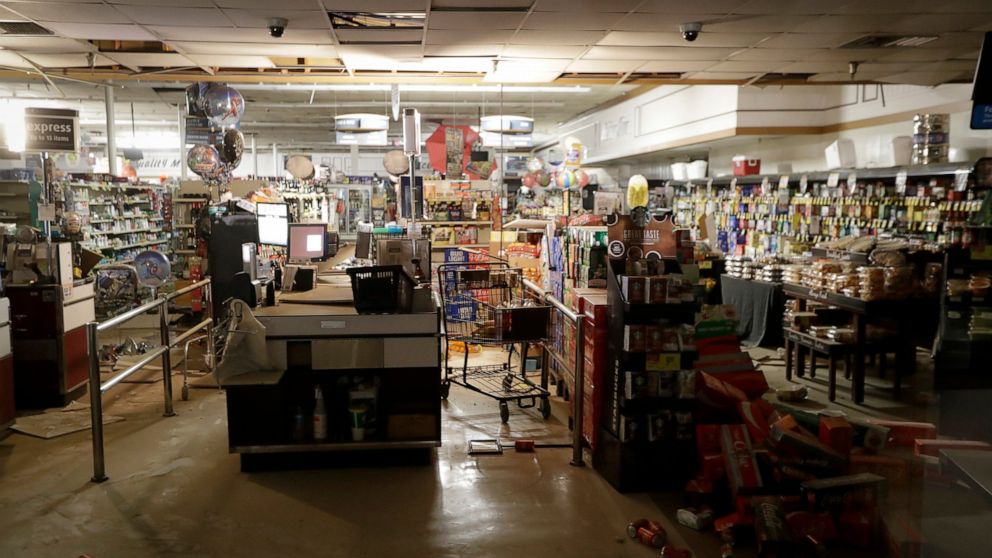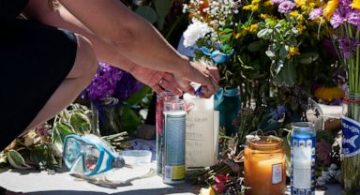
Crews in California assessed damage to cracked and burned buildings, broken roads, leaking water and gas lines and other infrastructure Saturday after the largest earthquake the region has seen in nearly 20 years jolted a remote stretch of country from Sacramento to Mexico.
No fatalities or major injuries were reported after Friday night’s 7.1-magnitude earthquake, and officials said damage did not initially appear as bad as expected and fewer than 200 people were in shelters.
But forecast temperatures of around 100 degrees (38 Celsius) and warnings by seismologists that large aftershocks were expected to continue for days — if not weeks — prompted further precautions.
The California National Guard was sending 200 troops, logistical support and aircraft, said Maj. Gen. David Baldwin. The Pentagon had been notified, and the entire California Military Department was put on alert, he said.
The quake struck at 8:19 p.m. Friday and was centered 11 miles (18 kilometers) from Ridgecrest, the same area of the Mojave Desert where a 6.4-magnitude temblor hit just a day earlier.
April Hamlin, a Ridgecrest native, said she was “already on edge” when the second quake hit. She and her three kids initially thought it was another aftershock.
“But it just kept on intensifying,” she said. “The TV went over, hanging by the cord. We heard it break. We heard glass breakage in the other rooms, but all we could do was stay where we were until it stopped.”
Nearby Naval Air Weapons Station China Lake, the Navy’s largest single landholding, said in a Facebook post that nonessential workers were evacuated and operations were halted “until further notice.”
In San Bernardino County, Gov. Gavin Newsom declared a state of emergency amid “conditions of extreme peril to the safety of persons and property.”
The California Office of Emergency Services brought in cots, water and meals and set up cooling centers, Director Mark Ghilarducci said.
State highway officials shut down a 30-mile (48-kilometer) section of State Route 178 between Ridgecrest and the town of Trona southwest of Death Valley, due to a rockslide and severe cracking. California Department of Transportation spokeswoman Christine Knadler said crews worked through the night to patch the roadway, but it remained rough and uneven. A $3 million emergency contract had been approved for repairs, she said.
Ron Mikulaco, 51, and his nephew, 23-year-old Brad Fernandez, stood on 178 on Saturday looking at the cracks in the road. The pair drove from Huntington Beach, some 170 miles (274 kilometers) southwest of Ridgecrest. Mikulaco, an amateur geologist, wanted to show his nephew “the power of Mother Nature,” and they had the epicenter’s latitude and longitude coordinates ready.
“We put that in the GPS and we’ll get as close as we can,” Fernandez said.
In Ridgecrest, local fire and police officials said they were initially swamped by calls for medical and ambulance service. But police Chief Jed McLaughlin said there was “nothing but minor injuries such as cuts and bruises, by the grace of God.”
Two building fires — one involving a mobile home — were quickly doused, McLaughlin said, and natural gas lines where leaks were reported were shut off.
The light damage was largely due to the remoteness of the area where the tremblor occurred. Only 28,000 people live in the Ridgecrest area, which is sandwiched between Southern California, with a population of 24 million, and Las Vegas’ Clark County, with 2.2 million.
Ridgecrest Mayor Peggy Breeden said some “bad people” came into the community after the quake and tried to steal items from local businesses. McLaughlin said one business was burglarized, with “a very expensive piece of equipment stolen.”
Trona, with about 2,000 residents, was reported to have at least one collapsed building. Roads were buckled or blocked, and police put out a call for bottled water for residents.
Antoun Abdullatif, 59, owns liquor stores and other businesses in Ridgecrest and Trona.
“I would say 70% of my inventory is on the floor, broken,” he said Saturday morning in Ridgecrest. “Every time you sweep and you put stuff in the dust bin, you’re putting $200 in the trash.”
But he has stopped cleaning up, believing another earthquake is on the way.
“We are waiting but I hope it doesn’t come,” he said.
There is about a 1-in-10 chance that another 7.0 quake could hit within the next week, according to Lucy Jones, a seismologist at the California Institute of Technology and a former science adviser at the U.S. Geological Survey. The chance of a 5.0-magnitude quake “is approaching certainty,” she added.
She said the new quake probably ruptured along about 25 miles (40 kilometers) of fault line and was part of a continuing sequence. The seismic activity is unlikely to affect fault lines outside of the area, Jones said, noting that the gigantic San Andreas Fault is far away.
In Los Angeles, 150 miles (241 kilometers) away, the second quake rattled Dodger Stadium in the fourth inning of the team’s game against the San Diego Padres. But the game went on, and the Padres won, 3-2.
“Not many people can say they threw a strike during an earthquake,” Eric Lauer, who was on the mound at the time, said later. “My ball, my pitch, started an earthquake.”
“Everyone was jumping over us to leave,” said Daniel Earle, 52, of Playa del Rey, who was sitting with his wife in the stadium’s reserve level. “My wife was holding us, like squeezing. I’m surprised my arm is still here.”
———
Antczak reported from Los Angeles. Nguyen reported from San Francisco. Associated Press writers Julie Carr Smyth in Columbus, Ohio, Brady McCombs in Salt Lake City, Juliet Williams in San Francisco, Adam Beam in Sacramento, Stefanie Dazio and Robert Jablon in Los Angeles, Tarek Hamada in Phoenix, Sports Writer Beth Harris in Los Angeles and Associated Press freelancer Jolene Latimer in Los Angeles contributed to this report.





